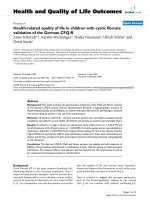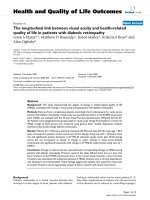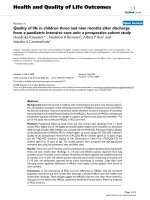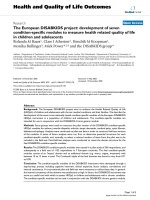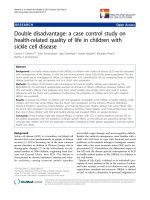Pain, motor function and health-related quality of life in children with cerebral palsy as reported by their physiotherapists
Bạn đang xem bản rút gọn của tài liệu. Xem và tải ngay bản đầy đủ của tài liệu tại đây (268.46 KB, 6 trang )
Badia et al. BMC Pediatrics 2014, 14:192
/>
RESEARCH ARTICLE
Open Access
Pain, motor function and health-related quality of
life in children with cerebral palsy as reported by
their physiotherapists
Marta Badia1, Inmaculada Riquelme2,3, Begoña Orgaz1, Raquel Acevedo4, Egmar Longo1 and Pedro Montoya2*
Abstract
Background: Children and adolescents with cerebral palsy suffer from higher levels of pain than their peers
without disability. The aim of this study was to explore the impact of pain on health-related quality of life and
motor function in individuals with cerebral palsy as reported by health professionals.
Methods: Cross-sectional study carried out in Associations for Care of Individuals with Cerebral Palsy and
Related Disabilities (ASPACE) in Balearic Islands and Castile Leon (Spain). Thirty-five physiotherapists rated pain,
health-related quality of life and motor function in 91 children and adolescents with cerebral palsy [8-19y]. A
semi-structured interview was used to collect demographic and clinical data according with the Study of
Participation of Children with Cerebral Palsy Living in Europe (SPARCLE).
Results: Physiotherapists reported that 51% of individuals with cerebral palsy suffered from pain. Physiotherapists
also perceived that pain in individuals with cerebral palsy was responsible for reductions of psychological but not
physical domains of health-related quality of life. According with physiotherapists’ estimations, motor impairment
scores were not correlated with pain scores in individuals with cerebral palsy, but they were significantly associated
with physical and autonomy domains of health-related quality of life.
Conclusions: These findings highlighted the importance of assessing and providing interventions for pain relief in
persons with cerebral palsy even at an early age.
Keywords: Pain, Cerebral palsy, Quality of life, Motor function, Adolescents, Child development
Background
There is a growing recognition that pain is a significant
problem in children and adolescents with cerebral palsy
(CP). More than 50% of children with CP suffer pain
from moderate to severe intensity on a daily basis and at
multiple body locations [1-5]. Pain usually interferes
with physical function, school, daily care activities, sleep
and mental health [6-9]. Moreover, chronic pain may
negatively affect health-related quality of life (HRQOL),
limiting life satisfaction [4,10-12] and health perception
in CP [9,13]. In this sense, HRQOL is considered a
multidimensional construct that embraces several domains of physical and psychological well-being [13-17].
* Correspondence:
2
Research Institute on Health Sciences (IUNICS), University of Balearic Islands,
Carretera de Valldemossa km 7.5, 07122 Palma, Spain
Full list of author information is available at the end of the article
Moreover, suffering from persistent pain seems to reduce emotional, social and physical domains of HRQOL
in children with CP [14].
Although self-report is the gold standard for pain and
HRQOL assessment in pediatric settings, it may be difficult
to obtain reliable information from children with severe intellectual impairments or significant communication problems [10]. In this sense, some authors have suggested the
possibility to assess children’s HRQOL and pain by using
reports from proxies [parents, health professionals, and
teachers] [18]. Indeed, several studies have used parents’
reports to assess HRQOL and pain prevalence in pediatric
population with CP [3,6]. Nevertheless, little is known
about health professionals’ estimations of pain and HRQOL
in children with CP, despite its importance on treatment
choices, patient-doctor relationship, and psychosocial
© 2014 Badia et al.; licensee BioMed Central Ltd. This is an Open Access article distributed under the terms of the Creative
Commons Attribution License ( which permits unrestricted use, distribution, and
reproduction in any medium, provided the original work is properly credited.
Badia et al. BMC Pediatrics 2014, 14:192
/>
pain management during healthcare-related pain-inducing
procedures [12,19-22].
The aim of the present study was to analyze health
professionals’ perceptions of pain and HRQOL in children and adolescents with CP, as well as to explore the
impact of pain on HRQOL as perceived by health professionals. Based on previous work indicating that pain
may play a key role in HRQOL in children with CP, we
hypothesized that physiotherapists would rate participants with pain as more impaired in the physical, emotional and social domains of HRQOL than participants
without pain. Moreover, consistent with previous results
showing that pain is more frequent in children with
poorer physical conditions [2,6,23] and that recurrent
musculoskeletal pain is associated with reduced HRQOL
[9], we further explored physiotherapists’ estimations of
pain and HRQOL in individuals with CP and different
levels of motor function.
Method
Design and procedure
This cross-sectional study was carried out between
September 2011 and February 2012. Physiotherapists were
initially contacted by one of the authors to explain the details of the study. Physiotherapists who were treating children and adolescents with CP on a regular schedule (at
least one 45-minute session during 2–3 days/week) were
asked to participate in the study and to answer several
questionnaires concerning pain, HRQOL, level of motor
function and demographic data for each individual with
CP. Inclusion criteria were: 1) individuals with CP should
be treated by physiotherapists at least during the previous
six months, and 2) age of individuals with CP should be
between 8 and 19years old. Parental informed written
consent was obtained for all individuals with CP. The
study was approved by the Ethics Committee of University
of Salamanca (Spain).
Participants
A convenience sample of children and adolescents with
CP and their physiotherapists were recruited from associations for the care of individuals with cerebral palsy
and related disabilities (ASPACE) in Balearic Islands and
Castile Leon (Spain). Forty-five physiotherapists treating
this sample were contacted, and 35 of them (78%) decided to participate in the study. Physiotherapists’ reports from 91 individuals with CP were obtained. The
sample of individuals with CP was composed of girls
(54.9%) and boys (45.1%) with a mean age of 12years old
(range between 8 and 19years).
Measures
Physiotherapists completed an interview-based protocol with items about sociodemographic and clinical
Page 2 of 6
characteristics (pain, motor function and health-related
quality of life) of individuals with CP. Physiotherapists
were asked to assess individual’s behavior by direct observation of participants.
Bodily pain and discomfort
Physiotherapists reported presence and severity of pain
in individuals with CP by using the SPARCLE [Study of
Participation of Children with Cerebral Palsy Living in
Europe] protocol [24]. This protocol assesses pain with
two items of the domain Bodily Pain and Discomfort
from the Child Health Questionnaire [25]. In this questionnaire, pain was evaluated by two items: 1) a yes/no
question about the presence of physical pain in the last
4weeks, and 2) a question about pain intensity (0 = none,
1 = low, 2 = moderate or 3 = severe pain).
Gross motor function classification system (GMFCS)
Physiotherapists completed the GMFCS to classify the
level of motor function of their patients with CP [26]. This
instrument classifies functional mobility into five levels,
with level I indicating the highest motor function independence and level V, the lowest gross motor function.
Health-related quality of life (HRQOL)
Physiotherapists assessed health-related quality of life
(HRQOL) in children and adolescents with CP by using
the Spanish version of the KIDSCREEN [17]. This questionnaire provides information of HRQOL through 52
items grouped into10 dimensions: Physical Well-being
(5 items), Psychological Well-being (6 items), Moods and
Emotions (7 items), Self-Perception (5 items), Autonomy
(5 items), Parent Relations and Home Life (6 items), Social
Support and Peers (6 items), School Environment (6
items), Social Acceptance (Bullying) (3 items), and Financial Resources (3 items). Cronbach’s alpha values are
greater than .70 for all dimensions [17]. The questionnaire
includes a version for children and adolescents aged between 8 and 18 years and a version for parents/proxy. The
proxy version of this questionnaire was applied in the
present study. Raw scores were transformed to T-scores
(mean = 50 and standard deviation = 10) with higher
values indicating higher HRQOL.
Data analysis
Spearman correlations were computed to test the relationship between different domains of HRQOL and
levels of motor function, as well as pain intensity. Statistical analysis was performed with SPSS v.19. The significance level was set at p < .05.
Results
Table 1 displays sociodemographic and clinical characteristics of individuals with CP. Most participants had
Badia et al. BMC Pediatrics 2014, 14:192
/>
Page 3 of 6
Table 1 Clinical and sociodemographic characteristics of
children and adolescents with cerebral palsy (n = 91)
assessed by physiotherapists (n = 35)
Clinical variable
N
%
Male
41
45.1
Female
50
54.9
Bilateral spastic
57
62.6
Unilateral spastic
10
11.0
Other (diskinetic, ataxic, mixed)
24
26.4
Yes
38
51.4
No
36
48.6
None
36
50.0
Mild
22
30.6
Moderate
9
12.5
Severe
5
6.9
Level I
17
18.7
Level II
20
22.0
Gender
Type of cerebral palsy
Pain present in the last 4weeks
Pain intensity
Motor impairment (GMFCS)
Level III
7
7.7
Level IV
10
11.0
Level V
37
40.6
None
10
11.0
Mild
31
34.0
Cognitive impairment
Moderate
22
24.2
Severe
28
30.8
Comorbidities
Epilepsy
38
41.8
bilateral spastic diplegia (62.6%) with high levels (IV-V)
of motor dysfunction (51.6%), moderate to severe cognitive impairment (55%), and communication problems
(59.3%), visual disability (48.4%), behavioural problems
(41.8%) and epilepsy as major comorbidities (Table 1).
Physiotherapists reported that pain (defined as persistent physical pain perceived during the last four weeks)
was present in 51.4% of children and adolescents with CP.
Moreover, pain was perceived as mild in 61.1%, as moderate in 25.0%, and as severe in 13.9% of participants. Table 2
displays physiotherapists’ ratings (standardized T-scores)
of health-related quality of life (HRQOL) in individuals
with cerebral palsy. Physiotherapists estimated that most
domains of HRQOL in individuals with CP were within
one standard deviation below the mean (all T-scores > 40)
as compared with normative data. In the case of physical
well-being, group average was more than one standard deviation below the mean (T-score = 38.4).
Significant negative correlations were obtained between
physiotherapists’ estimations of pain intensity and HRQOL
domains such as psychological well-being and school environment (Table 3), indicating that high levels of pain were
associated with lower HRQOL in these domains. Significant correlations were also found among physiotherapists’
estimations of motor impairment and physical well-being,
autonomy and social acceptance domains of the HRQOL.
In the case of physical well-being and autonomy, physiotherapists considered that impaired motor function was associated with reduced levels of HRQOL in these domains,
whereas impaired motor function was related to high social
acceptance. No significant correlation was found between
physiotherapists’ estimations of level of motor impairment
and pain intensity.
Discussion
The aim of the present study was to analyze physiotherapists’ perceptions of pain and HRQOL in individuals
Hearing disability
7
7.7
Visual disability
44
48.4
Behavior problems
38
41.8
Communication problems
54
59.3
Table 2 Mean and SD of standardized T-scores on
health-related quality of life domains in individuals with
cerebral palsy (CP) as assessed by physiotherapists
Feeding problems
31
34.1
Domains
n
Mean (SD)
Physical well-being
59
38.4 (7.8)
Psychological well-being
70
46.3 (9.9)
Moods and emotions
59
48.2 (9.4)
Self-perception
52
46.6 (8.2)
Type of schooling
Regular school
25
27.5
Special school
63
69.3
Both
3
3.2
Technical aids and services
Wheelchair
46
50.5
Orthopedic
39
42.9
Communication
27
29.7
Autonomy
61
44.1 (11.1)
Parent relations and home life
53
47.4 (10.6)
Social support and peers
51
43.7 (10.2)
School environment
76
51.7 (6.5)
Social acceptance (bullying)
75
48.3 (10.0)
Financial resources
33
46.6 (13.2)
Badia et al. BMC Pediatrics 2014, 14:192
/>
Page 4 of 6
Table 3 Spearman correlations between physiotherapists’
estimations of health-related quality of life (higher
scores = best health-related quality of life), level of motor
function (higher scores = worst motor function) and pain
intensity (higher scores = most severe pain) in individuals
with cerebral palsy
Domains
Level of motor function Pain intensity
n
n
Physical well-being
51
-.40**
50
-.23
Psychological well-being
63
-.13
59
-.27*
Moods and emotions
52
.08
52
-.15
Self-perception
45
.03
45
-.05
Autonomy
53
-.23*
51
.07
Parent relations and home life
47
-.05
44
-.13
Social support and peers
44
-.16
44
.23
School environment
67
.03
62
-.27*
Social acceptance (bullying)
67
.29**
56
.20
Financial resources
30
-.11
27
-.12
*p < .05.
**p < .01.
with CP. Physiotherapists estimated that more than half
of individuals with CP were suffering from pain of mild
intensity. This finding was in agreement with previous
research indicating that persons with CP experience
persistent pain [4,27] on a daily or weekly basis [1,3-5].
Thus, this data may suggest that physiotherapists can accurately recognize pain in their patients with CP. Given
that pain symptoms make children with neurological impairments especially vulnerable to poor pain management
[28], the adequate recognition of pain in individuals with
CP by physiotherapists was of paramount importance.
We also found that health professionals associated
pain with significant reductions of positive emotions and
life satisfaction in children and adolescents with CP.
This was also in agreement with previous studies with
self-reports and proxy-reports from parents showing
that pain affected emotional and psychological wellbeing in individuals with CP [6,10-12,18,29]. A relevant
finding of the present study was that physiotherapists
considered that pain in cerebral palsy was not associated
with low HRQOL scores in the physical domain. This
finding differed from data obtained from children and parents’ reports, showing significant correlations between
pain and physical components of quality of life and mobility [10,23]. This disagreement between physiotherapist
and patients’ perception of pain consequences has been
also shown by studies in other situations, such as pain induced by mobilizations [30], where health professionals
emphasized the positive over the negative dimensions of
procedural pain. Moreover, these findings underlined the
importance of psychosocial factors as predictors of pain,
as well as the role of biopsychosocial models for understanding chronic pain in persons with CP [31].
On the other hand, although physiotherapists reported
no significant relationship between motor disability and
pain, increased motor impairment was related to low
physical well-being and limited autonomy. Our data seems
to be in agreement with previous reports [10,14,18]. Thus,
for instance, high motor impairment has been associated
with lower physical activity, energy and fitness and lower
self-determination in individuals with CP [10,14,18,32].
Furthermore, previous studies analyzing professionals’ reports have shown that the severity of child’s physical impairment is associated with lower quality of life in physical
well-being and autonomy domains of the KIDSCREEN
questionnaire [18]. In addition, our results suggested that
impairments in gross motor function could be linked to a
lower risk of having poor HRQOL in social acceptance
domains. A possible explanation of this result could be
that children with CP are less frequently in contact with
their non-disabled peers [10] and, therefore, they might
have less possibilities of feeling rejected or harassed.
Furthermore, health professionals perceived that enhanced pain was associated with reduced life satisfaction
and negative feelings towards school in individuals with
CP. This finding was in agreement with previous data
from parents and self-reports showing that severe pain
in children with spastic CP also led to impaired school
performance [8]. Furthermore, it has been shown that
severe pain could be a determinant of psychological adjustment, and that emotional symptoms may be significantly increased with the presence of severe pain in CP
[33]. A comprehensive assessment of pain in CP would
require documenting pain history (e.g., presence of surgical interventions) and collecting information about
biopsychosocial factors (e.g. anxiety, depression) which
could be relevant for the maintenance of pain over time.
An appropriate recognition of pain by physiotherapist,
together with a comprehensive assessment of pain may
allow health professionals to provide adequate coping
strategies for better pain management in children and
adolescents with cognitive impairments and poor communication abilities, such as individuals with CP. In this
sense, our findings specifically addressed the importance
of HRQOL and pain assessment carried out by physiotherapists who often treat individuals with CP on a regular
schedule and are often the first caregiver to notice a
change in HRQOL and pain. Nevertheless, it should be
noted that parents and health professionals may have
different perceptions of child’s HRQOL and pain in several chronic diseases (e.g., leukaemia, juvenile idiopathic
arthritis, asthma or cystic fibrosis) [34]. Thus, our study
suggested that, whenever possible, multi-respondent assessment of HRQoL and pain should be considered in
individuals with cerebral palsy.
Badia et al. BMC Pediatrics 2014, 14:192
/>
This study has some limitations that must be taken into
account for interpretation of results. The analysis of pain
and health-related quality of life in children and adolescents with cerebral palsy was based only on surrogate pain
reports provided by their physiotherapists. Nevertheless, a
combination of self-reports and proxy-reports from parents, caregivers and health professionals would have provided a better understanding of pain and health-related
quality of life in this population. Although our sample of
individuals with CP was selected from educational settings
in different Spanish regions, sample size and response
rates were low. Moreover, our sample of children and adolescents with CP displayed different levels of cognitive impairment (ranging from none to severe), which may have
differentially influenced health professionals’ perception
about their pain and health-related quality of life. The
cross-sectional design of the present study represents a
further limitation, as it can be used only to describe pain
and HRQOL characteristics that exist in the population
of children and adolescents with CP, but not to determine cause-and-effect relationships among these variables and other relevant factors as mobility, cognitive
impairment or type of CP. Nevertheless, although our
study does not provide information about the influence
of pain on HRQOL over time in CP, it lays a scientific
basis for the implementation of a longitudinal design
and guides the selection of appropriate outcome measures for future studies.
Conclusions
In conclusion, health professionals perceived a high prevalence of pain in their patients with CP. Physiotherapists also
reported that pain might lead to significant reductions on
psychological well-being and school domains of HRQOL.
Moreover, they considered that motor impairment rather
than pain could be relevant for the reduced quality of life in
physical domain observed in children and adolescents with
CP. Our findings further underline the relevance of physiotherapist’s view about pain and HRQOL in pediatric patients with CP. More specifically, physiotherapists have a
particularly unique view about pain and health-related
quality of life in their CP patients and may be the first to report and intervene for pain. These results may contribute
to incorporate standard measures for the assessment and
design of therapeutic interventions and to guide pain management in persons with CP through their life span.
Abbreviations
CP: Cerebral palsy; HRQOL: Health-related quality of life; ASPACE: Associations
for Care of People with Cerebral Palsy and Related Disabilities;
SPARCLE: Study of Participation of Children with Cerebral Palsy Living in
Europe; GMFCS: Gross motor function classification system.
Competing interests
The authors declare that they have no competing interests.
Page 5 of 6
Authors’ contributions
MB conceived of the study, participated in its design and coordination,
participated in the performance of the statistical analysis and helped to draft
the manuscript. PM participated in the design of the study, participated in
the performance of the statistical analysis and revised the manuscript draft.
IR and LA participated in the design of the study, collected data, participated
in statistical analysis and helped to draft the manuscript. BO and RA
participated in statistical analysis and helped to draft the manuscript. All
authors read and approved the final manuscript.
Acknowledgements
Research was supported by grants from Regional Government of Castile and
Leon, Spain [Order SAN/103/2011; Official Gazette of Castile and Leon No.
173 of 7 of September], and the Spanish Secretary of State for R&D + i and
European Regional Development Funds (ERDF) (ref.:#PSI2010-19372).
Author details
1
INICO, Faculty of Psychology, University of Salamanca, Salamanca, Spain.
2
Research Institute on Health Sciences (IUNICS), University of Balearic Islands,
Carretera de Valldemossa km 7.5, 07122 Palma, Spain. 3Department of
Nursing and Physiotherapy, University of Balearic Islands, Palma, Spain.
4
ASPACE-Castile Leon, Faculty of Psychology, University of Salamanca,
Salamanca, Spain.
Received: 6 May 2013 Accepted: 16 July 2014
Published: 27 July 2014
References
1. Breau LM, Camfield CS, McGrath PJ, Finley GA: The incidence of pain in
children with severe cognitive impairments. Arch Pediatr Adolesc Med
2003, 157(12):1219–1226.
2. Doralp S, Bartlett DJ: The prevalence, distribution, and effect of pain
among adolescents with cerebral palsy. Pediatr Phys Ther 2010, 22:26.
3. Parkinson K, Gibson L, Dickinson H, Colver AF: Pain in children with
cerebral palsy: a cross sectional multicentre European study.
Acta Paediatr 2010, 99:446–451.
4. Riquelme I, Cifre I, Montoya P: Age-related changes of pain experience in
cerebral palsy and healthy individuals. Pain Med 2011, 12:535–545.
5. Engel JM, Petrina TJ, Dudgeon BJ, McKearnan KA: Cerebral palsy and
chronic pain: a descriptive study of children and adolescents. Phys Occup
Ther Pediatr 2005, 25:73–84.
6. Houlihan CM, O’Donnell M, Conaway M, Stevenson RD: Bodily pain and
health-related quality of life in children with cerebral palsy. Dev Med
Child Neurol 2004, 46:305–310.
7. Tervo RC, Symons F, Stout J, Novacheck T: Parental report of pain and
associated limitations in ambulatory children with cerebral palsy.
Arch Phys Med Rehabil 2006, 87:928–934.
8. Berrin SJ, Malcarne VL, Varni JW, Burwinkle TM, Sherman SA, Artavia K,
Chambers HG: Pain, fatigue, and school functioning in children with
cerebral palsy: a path-analytic model. J Pediatr Psychol 2007, 32:330–337.
9. Ramstad K, Jahnsen R, Skjeldal OH, Diseth TH: Mental health, health
related quality of life and recurrent musculoskeletal pain in children
with cerebral palsy 8–18 years old. Disabil Rehabil 2012, 34(19):1589–195.
10. Arnaud C, White-Koning M, Michelsen SI, Parkes J, Parkinson K, Thyen U,
Beckung E, Dickinson HO, Fauconnier J, Marcelli M, McManus V, Colver A:
Parent-reported quality of life of children with cerebral palsy in Europe.
Pediatrics 2008, 121:54–64.
11. Russo RN, Miller MD, Haan E, Cameron ID, Crotty M: Pain characteristics
and their association with quality of life and self-concept in children
with hemiplegic cerebral palsy identified from a population register.
Clin J Pain 2008, 24:335.
12. Swiggum M, Hamilton ML, Gleeson P, Roddey T, Mitchell K: Pain
assessment and management in children with neurologic impairment: a
survey of pediatric physical therapists. Pediatr Phys Ther 2010, 22:330.
13. Bjornson KF, Belza B, Kartin D, Logsdon R, McLaughlin J, Thompson EA: The
relationship of physical activity to health status and quality of life in
cerebral palsy. Pediatr Phys Ther 2008, 20:247.
14. Dickinson HO, Parkinson KN, Ravens-Sieberer U, Schirripa G, Thyen U, Arnaud C,
Beckung E, Fauconnier J, McManus V, Michelsen SI, Parkes J, Colver AF:
Self-reported quality of life of 8-12-year-old children with cerebral palsy: a
cross-sectional European study. Lancet 2007, 369:2171–2178.
Badia et al. BMC Pediatrics 2014, 14:192
/>
15. Waters E, Maher E, Salmon L, Reddihough D, Boyd R: Development of a
condition specific measure of quality of life for children with cerebral
palsy: empirical thematic data reported by parents and children.
Child Care Health Dev 2005, 31:127–135.
16. Aymerich M, Berra S, Guillamon I, Herdman M, Alonso J, Ravens-Sieberer U,
Rajmil L: Development of the Spanish version of the KIDSCREEN, a
health-related quality of life instrument for children and adolescents.
Gac Sanit 2005, 19:93–102.
17. Davis E, Shelly A, Waters E, Mackinnon A, Reddihough D, Boyd R, Graham HK:
Quality of life of adolescents with cerebral palsy: perspectives of
adolescents and parents. Dev Med Child Neurol 2009, 51:193–199.
18. White-Koning M, Grandjean H, Colver A, Arnaud C: Parent and professional
reports of the quality of life of children with cerebral palsy and associated
intellectual impairment. Dev Med Child Neurol 2008, 50:618–624.
19. Morrow AM, Hayen A, Quine S, Arnaud C: A comparison of doctors’,
parents’ and children’s reports of health states and health-related quality
of life in children with chronic conditions. Child Care Health Dev 2012,
38:186–195.
20. Kibele A: Occupational therapy’s role in improving the quality of life for
persons with cerebral palsy. Am J Occup Ther 1989, 43:371–377.
21. Turnquist KM, Engel JM: Occupational therapists’ experiences and
knowledge of pain in children. Phys Occup Ther Pediatr 1994, 14:35–52.
22. McKearnan KA, Kieckhefer GM, Engel JM, Jensen MP, Labyak S: Pain in
children with cerebral palsy: a review. J Neurosci Nurs 2004, 36:252.
23. Tarsuslu T, Livanelioglu A: Relationship between quality of life and
functional status of young adults and adults with cerebral palsy.
Disabil Rehabil 2010, 32:1658–1665.
24. Colver A, Group S: Study protocol: SPARCLE–a multi-centre European
study of the relationship of environment to participation and quality of
life in children with cerebral palsy. BMC Public Health 2006, 6:105.
25. Landgraf JL, Abetz L, Ware JE: The Child Health Questionnaire (CPQ): A User’s
Manual. Boston: The Health Institute; 1996.
26. Palisano R, Rosenbaum P, Walter S, Russell D, Wood E, Galuppi B:
Development and reliability of a system to classify gross motor function
in children with cerebral palsy. Dev Med Child Neurol 1997, 39:214–223.
27. Riquelme I, Montoya P: Developmental changes in somatosensory
processing in cerebral palsy and healthy individuals. Clin Neurophysiol
2010, 121:1314–1320.
28. Anand K, Craig KD: New perspectives on the definition of pain. Pain 1996,
67:3–6.
29. Tuzun EH, Guven DK, Eker L: Pain prevalence and its impact on the
quality of life in a sample of Turkish children with cerebral palsy. Disabil
Rehabil 2010, 32:723–728.
30. Alami S, Desjeux D, Lefèvre-Colau MM, Boisgard AS, Boccard E, Rannou F,
Poiraudeau S: Management of pain induced by exercise and mobilization
during physical therapy programs: views of patients and care providers.
BMC Musculoskelet Disord 2011, 12:172.
31. Jensen MP, Moore MR, Bockow TB, Ehde DM, Engel JM: Psychosocial
factors and adjustment to chronic pain in persons with physical
disabilities: a systematic review. Arch Phys Med Rehabil 2011, 92:146–160.
32. Livingston MH, Rosenbaum PL: Adolescents with cerebral palsy: stability
in measurement of quality of life and health-related quality of life over
1 year. Dev Med Child Neurol 2008, 50:696–701.
33. Parkes J, White-Koning M, McCullough N, Colver A: Psychological problems
in children with hemiplegia: a European multicentre survey. Arch Dis
Child 2009, 94:429–433.
34. Janse AJ, Sinnema G, Uiterwaal C, Kimpen JL, Gemke RJ: Quality of life in
chronic illness: children, parents and paediatricians have different, but
stable perceptions. Acta Paediatr 2008, 97:1118–1124.
doi:10.1186/1471-2431-14-192
Cite this article as: Badia et al.: Pain, motor function and health-related
quality of life in children with cerebral palsy as reported by their
physiotherapists. BMC Pediatrics 2014 14:192.
Page 6 of 6
Submit your next manuscript to BioMed Central
and take full advantage of:
• Convenient online submission
• Thorough peer review
• No space constraints or color figure charges
• Immediate publication on acceptance
• Inclusion in PubMed, CAS, Scopus and Google Scholar
• Research which is freely available for redistribution
Submit your manuscript at
www.biomedcentral.com/submit

